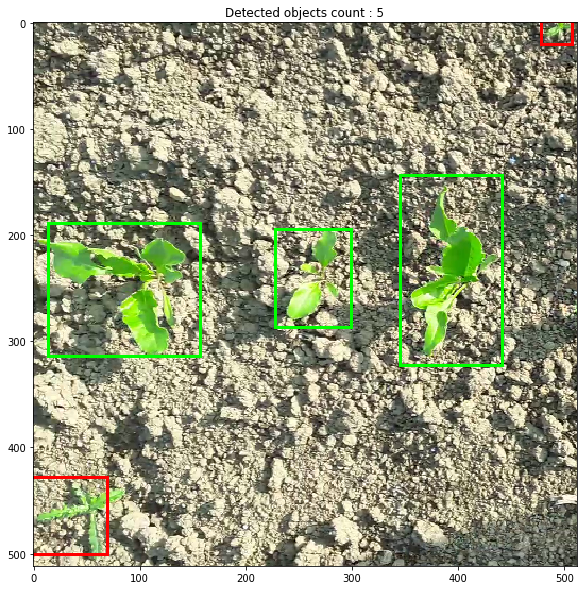Here is a jupyter notebook featuring a complete implementation from scratch of YOLOV2 with TensorFlow 2.0 :
- Dataset pipeline with data augmentation
- Training from YOLO pretrained weights
- Visualization of object detection
I use this notebook to train a model to detect crop and weeds in a field. The goal is to detect crop in real time for tractor guidance and to detect weeds to remove them.
Original paper : YOLO9000: Better, Faster, Stronger by Joseph Redmond and Ali Farhadi.
- Yolo_V2_tf_2.ipynb : Yolo V2 implementation with Tensorflow 2.0
- Yolo_V2_tf_eager.ipynb : old notebook, Yolo V2 implementation with Tensorflow 1.x with eager execution
- tensorflow 2.0
- imgaug
- cv2
- Download pretrained weights here. Place this weights file in notebook directory and name it
yolo.weights - The training requires four directories containing images and annotations :
train_image_folder/ : contains images files used during training (png format)
train_annot_folder/ : contains annotations in PASCAL VOC format (one xml file for each image)
val_image_folder/ : contains images files used for validation
val_annot_folder/ : contains annotations in PASCAL VOC format
- Define object's labels to detect (same labels as defined in PASCAL VOC xml file). Example :
LABELS = ('sugarbeet', 'weed')- Define image size in dataset and YOLO grid size. Image size must be YOLO grid size * 32.
IMAGE_H, IMAGE_W = 512, 512
GRID_H, GRID_W = 16, 16 # GRID size = IMAGE size / 32- Define train batch size and validation batch size : depends on image size and video card RAM.
TRAIN_BATCH_SIZE = 10
VAL_BATCH_SIZE = 10- Define path to dataset directories.
# Train and validation directories
train_image_folder = 'data/train/image/'
train_annot_folder = 'data/train/annotation/'
val_image_folder = 'data/val/image/'
val_annot_folder = 'data/val/annotation/'That's it, just run notebook cells to train YOLO on your own data!
YOLO model trained on sugarbeet and weed dataset (two labels) :
Many thanks to these great repositories:
https://github.com/experiencor/keras-yolo2
https://github.com/allanzelener/YAD2K
and to this very good explanation of the YOLO V2 loss function:
https://fairyonice.github.io/Part_4_Object_Detection_with_Yolo_using_VOC_2012_data_loss.html

